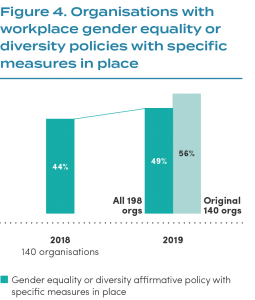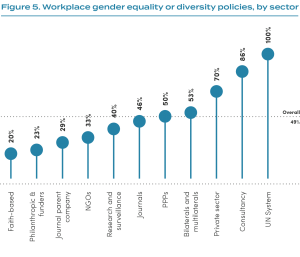Workplace gender equality policies: policy content yet to catch up with commitment to equality
Support for gender equality in the workplace means fostering a supportive organisational culture for all staff and requires corporate commitment, specific measures particularly at times of career transition points, and accountability.
Just half (97/198) of organisations have workplace gender equality or diversity and inclusion policies with explicit targets, strategies and/or plans.
Among the original sample of 140 organisations reviewed in both 2018 and 2019, progress has been made: 56% had workplace gender equality policies (up 24 from 44% in 2018). Twenty organisations appear to have adopted or enhanced workplace gender equality policies in the past year.
Transparency of organisational efforts to improve gender equality is also essential. Monitoring data over time and transparently sharing it with employees is critical to creating shared accountability, and understanding trends to recruit, develop and retain a gender diverse workforce.
Recommendations
3.1 Global organisations active in health should undertake assessments of whether and how gender equality is embedded in their institutions by, for example, using the International Gender Champions ‘How To’ Checklist.
3.2 Global organisations active in health should implement a range of interventions to promote gender equality in career progression including:
(i) Adopting clear policies to support staff in balancing personal, family and professional commitments such as flexible working arrangements and paid parental leave;
(ii) Implementing remuneration systems that ensure equal pay for equal work;
(iii) Rolling out systematic staff trainings, leadership and mentoring programmes and institutionalising space for dialogue, debate and learning on gender and gender equality in the workplace;
(iv) Including ‘gender competence’ in all job descriptions and performance monitoring systems to ensure accountability; and
(v) Demonstrating and implementing zero tolerance for sexual- and gender-based harassment.
3.3 Specific sectors should tailor approaches in line with their roles and functions in the global health landscape. For example, funders should consider attaching gender equality and gender workplace policy requirements to the funding eligibility of grantee organisations.



